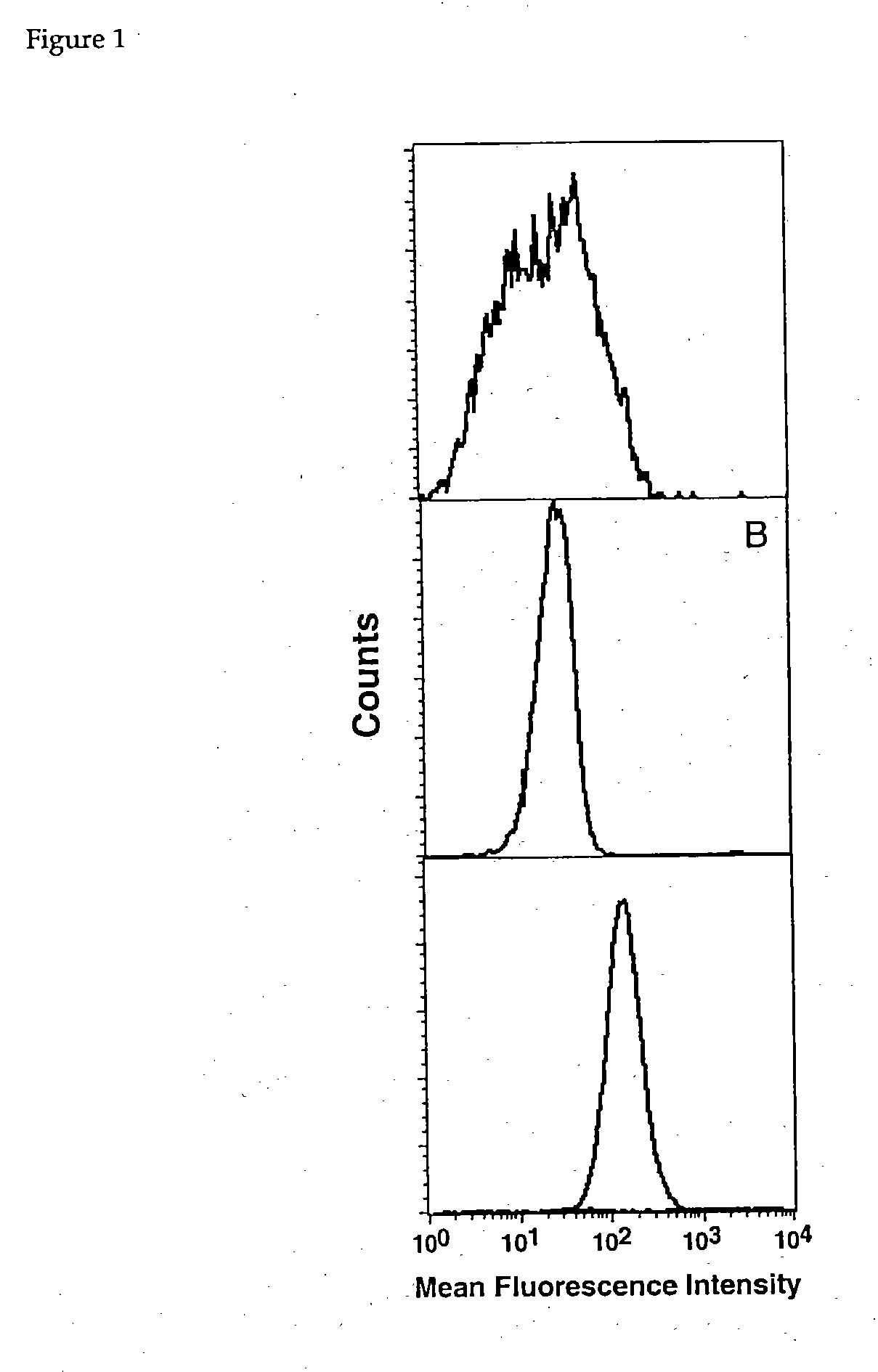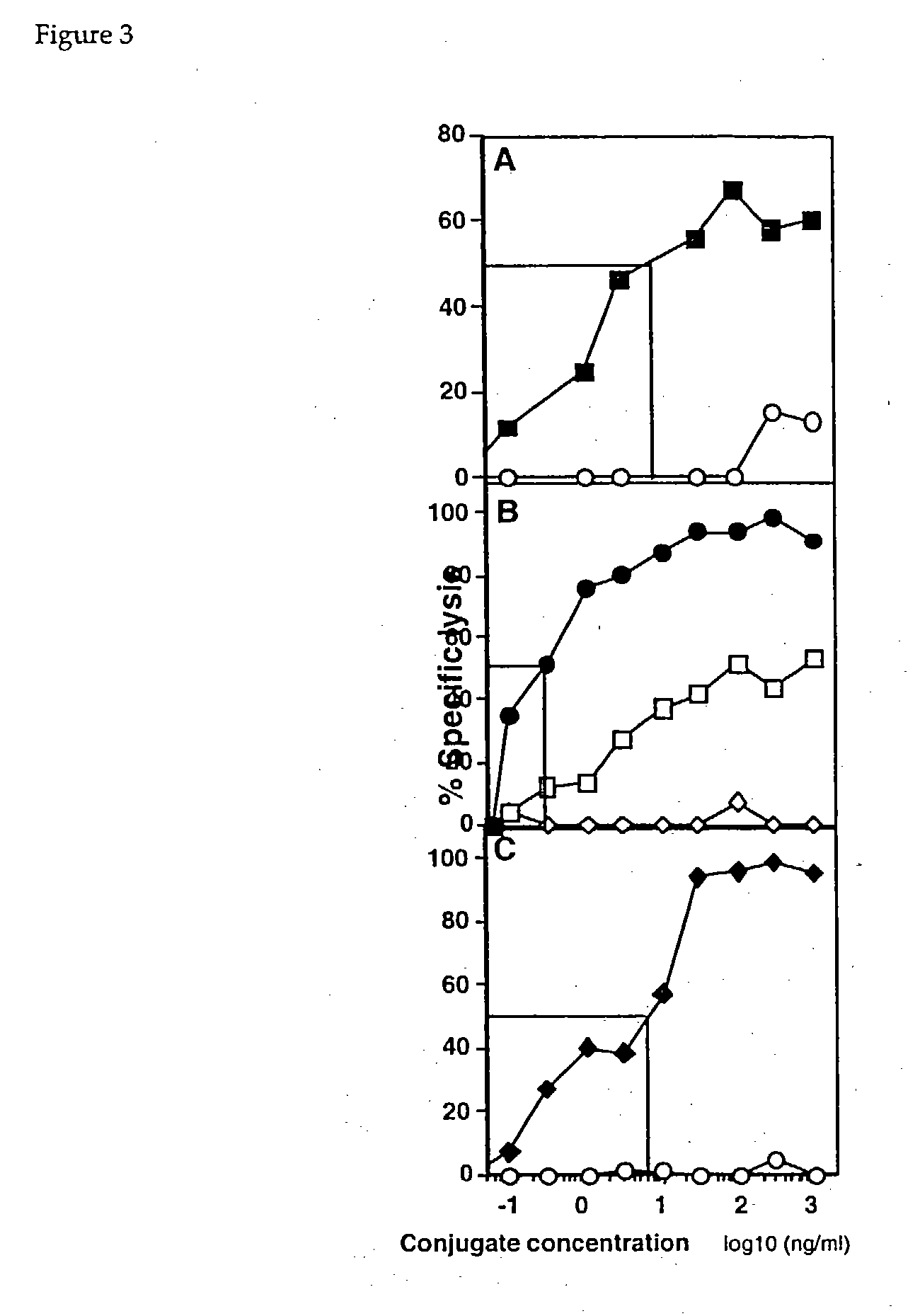Multicomponent conjugates which bind to target molecules and stimulate T cell lysis
a conjugate and target technology, applied in the direction of drug compositions, fusions for specific cell targeting, peptide/protein ingredients, etc., can solve the problems of statistically significant remission in .beta. cell lymphoma and breast cancer, inability to consider a complete in vivo model, and inability to efficiently kill the target cells to which they bind
- Summary
- Abstract
- Description
- Claims
- Application Information
AI Technical Summary
Problems solved by technology
Method used
Image
Examples
example 2
[0034] This example describes the formation of conjugates consisting of a monomeric M HC peptide complex of example 1, and a single murine Fab' fragment specific to carcinoembryonic antigen, or "CEA."
[0035] Buchegger, et al., J. Exp. Med., 158:413-427 (1983), incorporated by reference, describe murine IgG1 monoclonal antibody 35A7, against CEA. The mAb displays no cross reactivity for antigens expressed by granulocytes.
[0036] Monoclonal antibodies were incubated with pepsin, at a 3:100 wt / wt ratio of pepsin / mAb, and incubated at 37.degree. C. in 0.2M acetate buffer, pH 4.0, for 22 hours, to produce F(ab').sub.2 fragments. In turn, the F(ab').sub.2 fragments were reduced with 10 mM cysteamine, for 1 hour at 37.degree. C., in Hepes / NaCl buffer, pH 7.0, and then separated on a column. This yielded the Fab' fragments.
[0037] In order to conjugate the fragments with the molecules of example 1, the latter were incubated for 2 hours with a 25 molar excess of bismaleimide polyethylene oxide ...
example 3
[0041] This example describes the preparation of additional conjugates. Commercially available antibodies were used. Specifically, HERCEPTIN.RTM. is a recombinant, humanized mAb, of human IgG1.kappa. isotype, specific for the extracellular domain of the HER2 receptor. See Carter, et al., Proc. Natl. Acad. Sci USA, 89:4285-9 (1992), incorporated by reference. RITUXIMAB.RTM. is a chimeric, murine / human mAb of IgG1 human K subtype, directed against the CD20 molecule found on the surfaces of normal and malignant B lymphocytes. See Reff, et al., Blood, 83:435-445 (1994), incorporated by reference.
[0042] The same protocol that was used to prepare Fab' fragments in example 2 was used, with the following exceptions: The HERCEPTIN F(ab').sub.2 fragments were incubated with pepsin for 8 hours, and RITUXIMAB was incubated for 15 hours.
[0043] Fab' fragments, and conjugates with monomeric MHC molecules were prepared exactly as described in example 2.
example 4
[0044] This example describes flow cytometry analyses of the conjugates described in examples 2 and 3, supra.
[0045] Various cell lines were used, including LoVo, which is a colon carcinoma cell line that expresses CEA, SK-BR-3, which is a breast carcinoma cell line expressing HER 2 (ErbB2), and B cell lymphomas Daudi and Raji, both of which express CD20. The cells are all commercially available from the American Type Culture Collection. They were cultured in RPMI 1640, supplemented with 10% fetal calf serum. Daudi cells express no MHC Class I molecules, due to deletion of the .beta.2M gene. The other three cell lines are known to be HLA-A2 negative, a fact which was confirmed via assaying with an HLA-A2 specific antibody.
[0046] Samples of LoVo, SK-BR3 and Daudi cell lines were incubated with each conjugate, in 50.degree. C.l of PBS, containing 2% BSA, at a concentration of 2 .mu.g / ml for 1 hour at room temperature under gentle agitation. Cells were washed, three times, and then FITC...
PUM
| Property | Measurement | Unit |
|---|---|---|
| molecular weight | aaaaa | aaaaa |
| size | aaaaa | aaaaa |
| pH | aaaaa | aaaaa |
Abstract
Description
Claims
Application Information
 Login to View More
Login to View More - R&D
- Intellectual Property
- Life Sciences
- Materials
- Tech Scout
- Unparalleled Data Quality
- Higher Quality Content
- 60% Fewer Hallucinations
Browse by: Latest US Patents, China's latest patents, Technical Efficacy Thesaurus, Application Domain, Technology Topic, Popular Technical Reports.
© 2025 PatSnap. All rights reserved.Legal|Privacy policy|Modern Slavery Act Transparency Statement|Sitemap|About US| Contact US: help@patsnap.com



